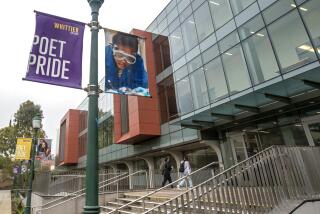Pierce College Backtracks on Size of Class Cuts
- Share via
WOODLAND HILLS — Stung by reports of deep cuts in the number of classes available next semester, Pierce College administrators have backtracked from their own initial estimate that classes would be cut by a third, but cannot agree on how substantial the cuts actually are.
Although administrators sought to reduce the original estimates, as of late afternoon Wednesday the college president was at odds with the dean of academic affairs over the key number needed to determine the magnitude of the cuts.
Both agreed, however, that the college next spring will offer a complete academic program of 1,390 classes, and said they want to reassure parents and students unsettled by reports of drastic cuts that Pierce is not falling apart.
But the extent of the cuts is still not clear, with the latest estimate that the spring schedule will offer 11% fewer classes than a year ago--the fourth attempt by Pierce administrators to quantify the cuts to reporters.
Initial reports, the subject of newspaper articles late last month, were based on statistics provided by Pierce, which is coping with the largest budget shortfall in the nine-campus community college system.
Also, the community colleges--including Pierce--have been ordered by the district’s Board of Trustees to get back to basics and eliminate nonessential classes that fail to attract enough students in an era of shrinking resources.
In interviews in late October, Pierce President E. Bing Inocencio and Dean of Academic Affairs Carlos Martinez agreed that roughly 2,000 courses had been offered at the Woodland Hills campus last spring, but 1,373 classes were on the schedule for next spring, a reduction of 627 classes, or 32%.
After the article was published, Martinez said the campus was deluged with calls from parents and students who feared the cuts signaled Pierce could not accommodate students’ needs and was headed for collapse.
The reaction prompted a reassessment of the data, which was found to be inaccurate, Martinez said.
Seeking to correct the misperception, college officials sent a letter to the editor of The Times that put the cuts at 11%, not 32%, but failed to acknowledge the source of the misinformation.
“The small percentage of classes that were reduced were those with traditionally minimal enrollments and those not needed for program completion or to meet general education requirements,” Pierce Vice President Carmelita Thomas wrote.
In an interview Wednesday, Martinez stuck by the 11% number.
The wide disparity between the original numbers provided by the college and the lower estimate was the result of an error that far inflated the number of class offerings last spring, thus making the reduction seem greater than it was, Martinez said.
“We didn’t give you the best information,” Martinez said.
The original computer printout tally was skewed because, for instance, it counted a chemistry class with two labs as three classes, not one, he said. Another problem, according to college President Inocencio, was that the same class offered under two majors was counted twice.
A count by hand, Martinez said, showed that 194 classes had been cut from the 1,584 offered last spring, leaving 1,390.
But in a later interview, Inocencio insisted that 2,097 classes were offered last spring--which jibes with the original estimate of a one-third cutback--but that perhaps some of the classes may have been canceled after failing to fill with students. He said he was unfamiliar with the lower base number of 1,584 used by Martinez.
If Martinez’s latest numbers are accurate, Pierce is cutting far fewer classes than campuses with smaller debts. At Valley College, for instance, classes for next spring have been cut by 20%.
A spokesman for the district, Vice-Chancellor Blair Sillers, said each campus is responsible for its own calculations and he could not explain the disparity among the various numbers provided by Pierce.
But Sillers said Pierce’s initial estimate of 32% cuts seemed high to him. While not speaking directly to Pierce’s roving statistics, Sillers said it is not unheard of for individual campuses to exaggerate their financial situation in hopes of attracting more money from the board.
“The colleges do have a mixed motivation there,” Sillers said.
While the debate over the numbers continues, college officials advise Pierce students to register early to avoid finding the classes they need already full.
More to Read
Sign up for Essential California
The most important California stories and recommendations in your inbox every morning.
You may occasionally receive promotional content from the Los Angeles Times.













